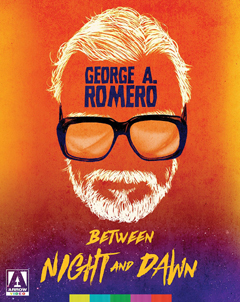 BETWEEN
NIGHT AND DAWN: THE LOST FILMS OF GEORGE ROMERO (1971-1973) Blu-ray/DVD
combo
BETWEEN
NIGHT AND DAWN: THE LOST FILMS OF GEORGE ROMERO (1971-1973) Blu-ray/DVD
comboDirector: George A. Romero
Arrow Video USA
 BETWEEN
NIGHT AND DAWN: THE LOST FILMS OF GEORGE ROMERO (1971-1973) Blu-ray/DVD
combo
BETWEEN
NIGHT AND DAWN: THE LOST FILMS OF GEORGE ROMERO (1971-1973) Blu-ray/DVD
comboThe three films George A. Romero directed between his two great zombie epics get some HD love with Arrow Video's Blu-ray/DVD combo boxed set BETWEEN NIGHT AND DAWN: THE LOST FILMS OF GEORGE ROMERO.
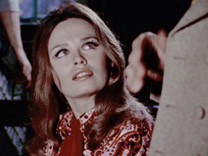
In the counter-culture romance THERE'S ALWAYS VANILLA, Vietnam vet and session musician Chris Bradley (Raymond Laine, LADY BEWARE) tires of playing on other people's albums and takes to the road, returning without intending to his home town of Pittsburgh. Running into his father Roger (Roger McGovern) at a strip joint, he finds himself no more able to reconnect with him as adults (partying with strippers) than with Terri (Johanna Lawrence), the mother of his child Chris Jr. – whom he last saw years before when he slipped out to get some cigarettes – when they expect him to finally grow up. Not wanting to go home and be pressured by his parents, Chris literally runs into actress Lynn Harris (Judith Streiner, NIGHT OF THE LIVING DEAD's Judy) who is becoming disillusioned with the glamour of television commercials ("making things look better than they really are") after fending off the advances of Mephistophelean ad man Michael Dorian (Richard Ricci, KNIGHTRIDERS). While Lynn is willing to sleep with Chris, she refuses to go to bed with him, resulting in Chris camping out on her couch trying to write a novel while Lynn goes to work. Chris' combination of whimsy and biting social observations soon wears thin when Lynn learns that she is pregnant, and this time around Chris may not be the one who does the running.
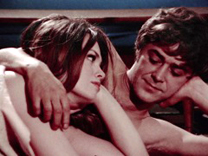 Despite
the monumental success of NIGHT OF THE LIVING DEAD, a follow-up feature from
George Romero and The Latent Image did not come until three years later with
this counter-culture romance. Shapeless and episodic with satirical jabs at
the television commercial industry and frolicking montages along with some now
tame but frank for the time sexuality, the film is held together not by Romero's
visual experimentation as editor and cinematographer but by trained actor Laine
who seems to know his character inside and out even if the script by Rudy Ricci
(THE BOOBY HATCH) is underdeveloped. Ridley is more passive in her performance
but manages to embody her character's feelings of not knowing what she wants
or is meant for (while Romero himself might not have been so compromising, the
ending suggests that Chris does not begrudge Lynn's retreat into conventionality).
NIGHT OF THE LIVING DEAD alumni John Russo (THE MAJORETTES), Vincent Survinski
(THE CRAZIES), Bill Hinzman (FLESHEATER), Russell Streiner (NIGHT's Johnny),
and George Kosana (NIGHT's sheriff) also appear in small roles. A good double
bill with this film would be SIDELONG GLANCES OF A PIGEON KICKER in which Princeton-educated
Jordan Christopher (CULT OF THE DAMNED) slums as a cab driver and enters a doomed
relationship with nice girl Jill O'Hara.
Despite
the monumental success of NIGHT OF THE LIVING DEAD, a follow-up feature from
George Romero and The Latent Image did not come until three years later with
this counter-culture romance. Shapeless and episodic with satirical jabs at
the television commercial industry and frolicking montages along with some now
tame but frank for the time sexuality, the film is held together not by Romero's
visual experimentation as editor and cinematographer but by trained actor Laine
who seems to know his character inside and out even if the script by Rudy Ricci
(THE BOOBY HATCH) is underdeveloped. Ridley is more passive in her performance
but manages to embody her character's feelings of not knowing what she wants
or is meant for (while Romero himself might not have been so compromising, the
ending suggests that Chris does not begrudge Lynn's retreat into conventionality).
NIGHT OF THE LIVING DEAD alumni John Russo (THE MAJORETTES), Vincent Survinski
(THE CRAZIES), Bill Hinzman (FLESHEATER), Russell Streiner (NIGHT's Johnny),
and George Kosana (NIGHT's sheriff) also appear in small roles. A good double
bill with this film would be SIDELONG GLANCES OF A PIGEON KICKER in which Princeton-educated
Jordan Christopher (CULT OF THE DAMNED) slums as a cab driver and enters a doomed
relationship with nice girl Jill O'Hara.

Released theatrically by Lee Hessel's Cambist Films as THE AFFAIR, THERE'S ALWAYS VANILLA was regarded as a lost film not so much due to official unavailability as lack of interest by Romero and the distributor. The film's first video release was from mail order Something Weird Video, with the first truly accessible release from Anchor Bay Entertainment on a double-sided DVD with SEASON OF THE WITCH. Sourced from a tape master provided by Films Around the World, the overmatted non-anamorphic 1.73:1 letterboxed, interlaced presentation left much to be desired despite being basically watchable. Sourced from a 2K scan of archival elements, Arrow's 1080p24 MPEG-4 AVC 1.33:1 pillarboxed fullscreen transfer reflects the film's origins as on 16mm color reversal film blown-up to 35mm with a grainy image and some colors so saturated that they appear to have been pumped up in the grading while skintones and other colors look more natural.
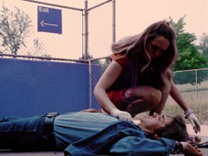 Travis
Crawford provides the first of three audio commentaries on this set, discussing
the film's failure commercially, Romero's lack of love for it and his unpleasant
experience making it, as well as the introduction of themes of individuality,
conformity, and being an iconoclast in a repressive society that would recur
not only in subsequent films (particularly KNIGHTRIDERS) but also in Romero's
own career (particularly with regard to the gaps in between productions and
the many failed development deals). "Affair of the Heart: The Making of
THERE'S ALWAYS VANILLA" (29:43) documentary expands upon the commentary
with comments from producers Russo and Streiner, actress Judith Streiner, actor
Richard Ricci (who later walked away from advertising and became a grip and
actor on other Romero films), and sound recordist Gary Streiner. They discuss
how the film originated in a thirty-minute short audition piece Rudy Ricci wrote
for Laine to take to Hollywood and Romero's desire to expand upon it even though
Ricci thought there was not enough material (with Romero adding the television
commercial business and later Laine's to-the-camera monologues to fill it out),
and a shooting schedule protracted by their regular jobs making commercials
and Ricci's fitful progress with the script.
Travis
Crawford provides the first of three audio commentaries on this set, discussing
the film's failure commercially, Romero's lack of love for it and his unpleasant
experience making it, as well as the introduction of themes of individuality,
conformity, and being an iconoclast in a repressive society that would recur
not only in subsequent films (particularly KNIGHTRIDERS) but also in Romero's
own career (particularly with regard to the gaps in between productions and
the many failed development deals). "Affair of the Heart: The Making of
THERE'S ALWAYS VANILLA" (29:43) documentary expands upon the commentary
with comments from producers Russo and Streiner, actress Judith Streiner, actor
Richard Ricci (who later walked away from advertising and became a grip and
actor on other Romero films), and sound recordist Gary Streiner. They discuss
how the film originated in a thirty-minute short audition piece Rudy Ricci wrote
for Laine to take to Hollywood and Romero's desire to expand upon it even though
Ricci thought there was not enough material (with Romero adding the television
commercial business and later Laine's to-the-camera monologues to fill it out),
and a shooting schedule protracted by their regular jobs making commercials
and Ricci's fitful progress with the script.

Carried over from the Anchor Bay disc is "Digging Up the Dead: The Lost Films of George Romero" (15:56) which focuses on both THERE'S ALWAYS VANILLA and SEASON OF THE WITCH. Of the former film, he recalls Laine's attempt at conquering Hollywood, Ricci's short (which he now prefers to the feature) and his frustration with the his progress on the feature script, and its distribution by Cambist (the film was purchased by Hessel's girlfriend). The disc also includes two image galleries, the first a filming locations gallery with audio commentary by Romero Historian Lawrence DeVincentz (11:30) who show the locations as they appeared in the film and as they are today, including the futuristic-looking tramway that did not actually go anywhere since it was actually a demonstration model on a circular track in a park (all that remains today is the derelict station), as well as a gallery of collectible scans (1:08), and the film's theatrical trailer (1:45).
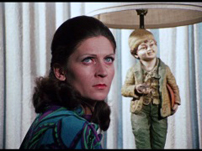 Approaching
middle-age, housewife Joan Mitchell's (Jan White, TOUCH ME NOT) unconscious
acknowledgement of her husband Jack's (Bill Thunhurst, THE CRAZIES) casual disregard
of her, her teenage daughter Nikki (Joedda McClain) no longer needing her, and
her lack of spiritual and sexual fulfillment take the form of vivid and surreal
dreams. Visiting self-proclaimed witch Marion (Virginia Greenwald) with her
friend Shirley (Ann Muffly, CREEPSHOW) for a Tarot card reading, Catholic Joan
is both afraid and fascinated with witchcraft, defined by Marion as more of
a religion than broomsticks and black cats. Joan is both repelled and subconsciously
attracted to Nikki's teacher's aide boyfriend Gregg (Laine) who humiliates Shirley
with an experiment on the power of the mind by "turning her on" with
a fake marijuana cigarette and gets her to confess her all of her insecurities.
When Joan comes back after taking Shirley home and overhears Nikki and Gregg
making love, Nikki runs away from home and Jack blames her. When Jack goes on
a business trip, Joan starts to experiment with witchcraft and casts a spell
summoning Gregg to her bed (well, the living room shag carpeting). When Joan's
dreams are invaded by a nightmarish figure in monster mask (NIGHT's Bill Hinzman,
who also photographed the film) who breaks into the house and attacks her, Joan
grows afraid that she has abused her powers and is being punished but her newfound
freedoms are tempting her toward becoming an initiate into Marion's coven and
an ultimate act of liberation.
Approaching
middle-age, housewife Joan Mitchell's (Jan White, TOUCH ME NOT) unconscious
acknowledgement of her husband Jack's (Bill Thunhurst, THE CRAZIES) casual disregard
of her, her teenage daughter Nikki (Joedda McClain) no longer needing her, and
her lack of spiritual and sexual fulfillment take the form of vivid and surreal
dreams. Visiting self-proclaimed witch Marion (Virginia Greenwald) with her
friend Shirley (Ann Muffly, CREEPSHOW) for a Tarot card reading, Catholic Joan
is both afraid and fascinated with witchcraft, defined by Marion as more of
a religion than broomsticks and black cats. Joan is both repelled and subconsciously
attracted to Nikki's teacher's aide boyfriend Gregg (Laine) who humiliates Shirley
with an experiment on the power of the mind by "turning her on" with
a fake marijuana cigarette and gets her to confess her all of her insecurities.
When Joan comes back after taking Shirley home and overhears Nikki and Gregg
making love, Nikki runs away from home and Jack blames her. When Jack goes on
a business trip, Joan starts to experiment with witchcraft and casts a spell
summoning Gregg to her bed (well, the living room shag carpeting). When Joan's
dreams are invaded by a nightmarish figure in monster mask (NIGHT's Bill Hinzman,
who also photographed the film) who breaks into the house and attacks her, Joan
grows afraid that she has abused her powers and is being punished but her newfound
freedoms are tempting her toward becoming an initiate into Marion's coven and
an ultimate act of liberation.
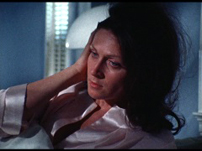
A psychological examination of burgeoning women's liberation and suburban malaise, SEASON OF THE WITCH would be marketed first as a softcore skin flick under the title HUNGRY WIVES and then as a horror film under its current title, although it actually began life as JACK'S WIFE. The moments of horror and surrealism are confined to dream sequences, from the attacks that might be an infernal incubus or (in a politically incorrect seventies twist) a "rape fantasy" to the tour of her home, family, and social life where she wants for nothing material while also having the emptiness of her existence revealed to her. She and Jack attend parties where dirty mad libs and jokes about casual sex are the height of wit while suspecting that their daughter's college education is teacher to take drugs and have sex ("Try to stay virgin," Jack calls to his daughter when she is on her way out for the evening), and "Stay stoned" is offered up as the equivalent of the older generation's "stay drunk" with regard to what physiological woes may be psychological in nature. There seems to be a logical interpretation for everything Joan achieves with her witchcraft, casting a spell seeming to have allowed her summon the courage to call Gregg, his appearance in her dream before she meets him explained away by a social situation in which they likely did meet in passing, and other elements of her dreams being not so much premonitions as revealing of the monotony and predictability of her life. Romero's visuals are more striking, the electronic score of Steve Gorn (THERE'S ALWAYS VANILLA) more experimental, and the pacing is refreshingly relaxed. The film remains intriguing as a time capsule (both ROSEMARY'S BABY and THE GRADUATE are knowingly referenced), a psychological drama, and even a feminist statement (or rumination at least).
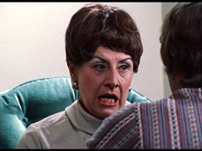 Released
theatrically by Jack H. Harris as HUNGRY WIVES in a cut (89:45) reportedly some
forty minutes short of the rumored 130 minute version – this version was
later retitled GEORGE A. ROMERO'S SEASON OF THE WITCH for theatrical reissue
and for its VHS release from Vista Entertainment. When Anchor Bay released the
film on tape and subsequently DVD, their cut turned out to be an extended version
running 104:20 in a version (overmatted to 1.76:1 on the non-anamorphic letterboxed
on the DVD). Arrow's transfer of the theatrical version under the HUNGRY WIVES
title has been mastered in 4K from the original camera negative, looking more
richly colorful than before and finer-grained than the 35mm blow-up transfers
(taking into account that transfers from those sources have been analogue-based).
Sadly, film materials for the extended cut appear not to exist, so the theatrical
version transfer has been augmented with standard definition excerpts for the
disc's alternate cut bearing the JACK'S WIFE title. The additions in this version
do flesh out the film and character more but also reveal that the cutting of
the theatrical version was quite judicious in the film's first half. Scenes
are mainly expanded, with the early party sequence revealing Joan's psychiatrist
(Neil Fisher) among the guests, some more details of Shirley's Tarot card reading
(along with her confession to Joan about the nature of the betrayal in her marriage),
a longer interview with the police after Nikki runs away, and more at the start
of Joan visiting Gregg at the college among other things. The theatrical cut
include an LPCM 1.0 mono track that is clean and free of the sound effects added
to the Anchor Bay track while the Blu-ray's iteration of Donovan's "Season
of the Witch" during Joan's shopping montage also sounds cleaner than it
did on the Anchor Bay tape (where an attempt to add a newer digital remastered
version of the track ran out of sync) as well as optional English SDH subtitles
while the extended cut has Dolby Digital 1.0 mono audio and no subtitles.
Released
theatrically by Jack H. Harris as HUNGRY WIVES in a cut (89:45) reportedly some
forty minutes short of the rumored 130 minute version – this version was
later retitled GEORGE A. ROMERO'S SEASON OF THE WITCH for theatrical reissue
and for its VHS release from Vista Entertainment. When Anchor Bay released the
film on tape and subsequently DVD, their cut turned out to be an extended version
running 104:20 in a version (overmatted to 1.76:1 on the non-anamorphic letterboxed
on the DVD). Arrow's transfer of the theatrical version under the HUNGRY WIVES
title has been mastered in 4K from the original camera negative, looking more
richly colorful than before and finer-grained than the 35mm blow-up transfers
(taking into account that transfers from those sources have been analogue-based).
Sadly, film materials for the extended cut appear not to exist, so the theatrical
version transfer has been augmented with standard definition excerpts for the
disc's alternate cut bearing the JACK'S WIFE title. The additions in this version
do flesh out the film and character more but also reveal that the cutting of
the theatrical version was quite judicious in the film's first half. Scenes
are mainly expanded, with the early party sequence revealing Joan's psychiatrist
(Neil Fisher) among the guests, some more details of Shirley's Tarot card reading
(along with her confession to Joan about the nature of the betrayal in her marriage),
a longer interview with the police after Nikki runs away, and more at the start
of Joan visiting Gregg at the college among other things. The theatrical cut
include an LPCM 1.0 mono track that is clean and free of the sound effects added
to the Anchor Bay track while the Blu-ray's iteration of Donovan's "Season
of the Witch" during Joan's shopping montage also sounds cleaner than it
did on the Anchor Bay tape (where an attempt to add a newer digital remastered
version of the track ran out of sync) as well as optional English SDH subtitles
while the extended cut has Dolby Digital 1.0 mono audio and no subtitles.

The film is also accompanied by another audio commentary by critic Travis Crawford on the theatrical cut in which he compares the film more to John Cassavetes' FACE and the films of Ingmar Bergman Romero might have seen in Pittsburgh art theaters than the horror genre; indeed, his later survey of Satanic cinema from ROSEMARY'S BABY to the year of the Romero film's release demonstrates that there are no films of the genre like SEASON (although it may have more in common with some of Joe Sarno's occult erotica of the late sixties, although Romero's "self-actualization through the occult" is more liberating than some of the erotic traps of the former's cultists). Drawing on Romero's statements about the film, he discusses the ways in which the director felt that the film was like his first movie in that he wrote the script and was able to experiment visually since he was no longer worrying about the basics of camerawork and editing. He covers some of the information familiar to Romero fans like the film being shot in the home of the parents of later wife Christine Forrest (MONKEY SHINES) and that his first wife Nancy was the film's producer. He provides some background on the Pittsburgh-area actors including Thunhurst, Laine, and White (who initially turned down the film out of concerns about its erotic content since Romero had written the script in a more salacious manner merely to attract funding). Crawford laments the title changes since he regards JACK'S WIFE as "the most elegant and telling title in Romero's filmography."
 "When
Romero Met Del Toro" (55:40) is a 2016 conversation between Romero and
filmmaker Guillermo del Toro (CRIMSON PEAK) in which the fanboy auteur gushes
about his youthful discovery of NIGHT OF THE LIVING DEAD and Richard Matheson's
I AM LEGEND – to which Romero reveals that his concept for NIGHT was wanting
to see how the plague started instead of the novel's aftermath – and crediting
Romero with solely inventing a modern horror genre. They also discuss the unintended
racial aspects of the film and the social changes of the times, as well as the
circumstances that lead to his starting to write DAWN OF THE DEAD before coming
into contact with Dario Argento. The freewheeling discussion moves back and
forth through his filmography, with del Toro and Romero becoming animated in
their discussion of KNIGHTRIDERS and whether the Arthurian protagonist is a
hero or "Jim Jones with a bike", the psychological basis of MARTIN
and the use of black-and-white, as well as THE CRAZIES which Del Toro credits
as a primary inspiration for THE STRAIN.
"When
Romero Met Del Toro" (55:40) is a 2016 conversation between Romero and
filmmaker Guillermo del Toro (CRIMSON PEAK) in which the fanboy auteur gushes
about his youthful discovery of NIGHT OF THE LIVING DEAD and Richard Matheson's
I AM LEGEND – to which Romero reveals that his concept for NIGHT was wanting
to see how the plague started instead of the novel's aftermath – and crediting
Romero with solely inventing a modern horror genre. They also discuss the unintended
racial aspects of the film and the social changes of the times, as well as the
circumstances that lead to his starting to write DAWN OF THE DEAD before coming
into contact with Dario Argento. The freewheeling discussion moves back and
forth through his filmography, with del Toro and Romero becoming animated in
their discussion of KNIGHTRIDERS and whether the Arthurian protagonist is a
hero or "Jim Jones with a bike", the psychological basis of MARTIN
and the use of black-and-white, as well as THE CRAZIES which Del Toro credits
as a primary inspiration for THE STRAIN.
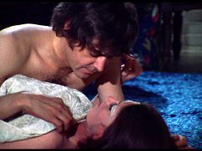
Carried over from the DVD is "The Secret Life of JACK'SWIFE" (17:16), an archival interview with actress White who discusses becoming involved in the project, shooting in the Forrest home (with Romero's fascination with two ornamental lamps seen throughout the film), getting unwelcome acting tips from Laine (who would become an acting teacher and appear sporadically in Pittsburgh-area films after his Hollywood sojourn), and the use of a body double in a few shots of the coven initiation sequence. The alternate opening titles include JACK'S WIFE (3:32) as seen on the extended cut, HUNGRY WIVES (3:35) optically zooms the title over the opening shot here whereas the title appears on black on the feature transfer, and SEASON OF THE WITCH (3:26) as seen on the Vista tape and the Anchor Bay DVD (the tape kept the JACK'S WIFE title). A shorter filming locations gallery (1:34) features another with audio commentary by DeVincentz as locations from the film are shown then and now, while a separate gallery includes collectibe scans (2:32). Trailers for both HUNGRY WIVES (1:31) – narrated by Harriet White Medin (THE HORRIBLE DR. HICHCOCK) – and SEASON OF THE WITCH (1:46) are also included.
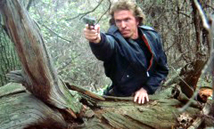 In
THE CRAZIES, fireman David (Will MacMillan, THE ENFORCER) responds to a house
fire to discover that a man (Regis Survinski) has murdered his wife and set
his home ablaze with his children inside, while David's pregnant nurse girlfriend
Judy (Lane Carroll, HERCULES IN NEW YORK) arrives at the office of Dr. Brookmyre
(Will Disney) to treat the burned children only to be inundated by military
personnel lead by Major Ryder (Harry Spillman, BORN AGAIN) who refuses to let
the patients be taken to the city hospital since the town has been quarantined
due to a viral outbreak from a military plane that crashed in the hills above
the town, its contents leaking into the artisanal springs that contribute to
the water supply. Judy is inoculated to safeguard against contact with further
patients, but Brookmyre gives her additional injections and tells her to slip
away and find David and to avoid contact with other people. Worried about rumors
of military presence in the town setting up a perimeter around the borders,
David and his partner Clank (Harold Wayne Jones, KNIGHTRIDERS) leave to find
Judy only to be rounded up with her, Artie (Richard Liberty, DAY OF THE DEAD)
and his daughter Kathy (Lynn Lowry, SHIVERS). The quintet manages to escape
and decide it would be better to hold up by themselves than be corralled into
the local high school with the other townspeople by soldiers using deadly force.
A harried Ryder is overwhelmed by the underequipped unit's attempts to account
for a population of three thousand plus spread out over the town and surrounding
farms but his superior Colonel Peckham (Lloyd Hollar) reveals that the material
code-named Trixie that the town has been exposed to is not a vaccine as believed
but a bacteriological weapon. Scientist Dr. Watts (Richard France, DAWN OF THE
DEAD) believes that he can be of more use back in Washington D.C. at the lab
since he too does not have adequate equipment at the doctor's office or the
school's labs, but Peckham is under orders from D.C. – where military
officials (including SEASON OF THE WITCH's Bill Thurnhurst) have decided that
nuclear measures may have to be taken to keep the infection from spreading –
not to let word of the outbreak spread outside of the town. As locals and soldiers
alike start succumbing to symptoms that lead to incurable madness or death and
turn on each other, a war erupts between the infected and the military with
David, Judy, Clank, Artie, and Kathy – who is either showing symptoms
or having a nervous breakdown – caught in between.
In
THE CRAZIES, fireman David (Will MacMillan, THE ENFORCER) responds to a house
fire to discover that a man (Regis Survinski) has murdered his wife and set
his home ablaze with his children inside, while David's pregnant nurse girlfriend
Judy (Lane Carroll, HERCULES IN NEW YORK) arrives at the office of Dr. Brookmyre
(Will Disney) to treat the burned children only to be inundated by military
personnel lead by Major Ryder (Harry Spillman, BORN AGAIN) who refuses to let
the patients be taken to the city hospital since the town has been quarantined
due to a viral outbreak from a military plane that crashed in the hills above
the town, its contents leaking into the artisanal springs that contribute to
the water supply. Judy is inoculated to safeguard against contact with further
patients, but Brookmyre gives her additional injections and tells her to slip
away and find David and to avoid contact with other people. Worried about rumors
of military presence in the town setting up a perimeter around the borders,
David and his partner Clank (Harold Wayne Jones, KNIGHTRIDERS) leave to find
Judy only to be rounded up with her, Artie (Richard Liberty, DAY OF THE DEAD)
and his daughter Kathy (Lynn Lowry, SHIVERS). The quintet manages to escape
and decide it would be better to hold up by themselves than be corralled into
the local high school with the other townspeople by soldiers using deadly force.
A harried Ryder is overwhelmed by the underequipped unit's attempts to account
for a population of three thousand plus spread out over the town and surrounding
farms but his superior Colonel Peckham (Lloyd Hollar) reveals that the material
code-named Trixie that the town has been exposed to is not a vaccine as believed
but a bacteriological weapon. Scientist Dr. Watts (Richard France, DAWN OF THE
DEAD) believes that he can be of more use back in Washington D.C. at the lab
since he too does not have adequate equipment at the doctor's office or the
school's labs, but Peckham is under orders from D.C. – where military
officials (including SEASON OF THE WITCH's Bill Thurnhurst) have decided that
nuclear measures may have to be taken to keep the infection from spreading –
not to let word of the outbreak spread outside of the town. As locals and soldiers
alike start succumbing to symptoms that lead to incurable madness or death and
turn on each other, a war erupts between the infected and the military with
David, Judy, Clank, Artie, and Kathy – who is either showing symptoms
or having a nervous breakdown – caught in between.

THE CRAZIES returns to the siege scenario of NIGHT OF THE LIVING DEAD while more cynically anticipating DAY OF THE DEAD more so than DAWN OF THE DEAD as the complete breakdown of communication between the military, town officials, and the townspeople leads to all-out war. Apart from the crazed father in the opening, we see almost nothing of the behavior of the "crazies" for the first half-hour in which the military is an invading force that manhandles, beats, loots, and puts down resistance – with Peckham announcing that anyone who resists should be treated as the enemy – so it is no surprise that vets David and Clank do not trust their authority with Vietnam and Kent State fresh in the minds of the public (Clark describes sums up the military as being able to "turn a college protest into a shooting war" and an infected priest whose sanctuary has been invaded by the soldiers to round up the parishioners douses himself in gasoline and sets himself alight in a moment that also recalls the rabies outbreak film I DRINK YOUR BLOOD which also utilized a willowy Lowry in a similar manner). The real horror of the crazies is in that they remain lucid enough to realize the horror of what they have done – not unlike the infected of Jean Rollin's GRAPES OF DEATH – be it murder, infanticide, or attempted incest. The officials in D.C. are more concerned with covering their asses – reporting the nuclear weapon hovering above the city as a training exercise and planning to say "it just went off" if they need to use it – while here more so than DAY OF THE DEAD it is more understandable to that the scientists and the soldiers get caught up in playing the blame game considering just how badly the situation has been handled from the start and how unprepared they still are knowing what to expect days before the first incident. While DAY OF THE DEAD could be conjectured as the natural bitter end of the zombie outbreak, THE CRAZIES perhaps shows why the audience and Romero himself might have found the staying with the outcasts of DAWN OF THE DEAD a more entertaining and ultimately more moving experience. THE CRAZIES, on the other hand, is imperfect thanks to performances that range from functionary to hyperbolic, plenty of talk with action illustrated by obvious stock footage cutaways, and the crazies who as a teaming mass are less reminiscent of Romero's zombies than the guerilla crowd scene scramblings of the third act of Cronenberg's RABID (which was at its best in its more intimate scenes of horror). The film's end credits are accompanied by the moody and mournful "Heaven Help Us" by Beverly Bremers. Producer Hessell's wife Edith Bell appears as Watts' lab assistant.
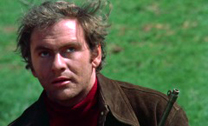 Released
theatrically by producer Lee Hessell (VAMPYRES), THE CRAZIES has been the most
accessible of the three films in this set throughout the video era with the
original Vista Home Video release ubiquitous on video shelves before being replaced
by Anchor Bay's VHS and later Blue Underground's 2003 special edition DVD and
2010 Blu-ray with director's commentary by Romero. Scanned in 4K from 35mm archival
elements – the source of a new 4K DCP making the theatrical rounds –
Arrow's 1080p24 MPEG-4 AVC 1.66:1 widescreen Blu-ray is the best-looking of
the set as befits Romero's return to 35mm filmmaking. The element has been cleaned
up and sports more subdued primaries than the Blue Underground but still remains
colorful and reveals slivers more information on all sides of the frame. The
sole audio option is an LPCM 1.0 mono track that is clean enough to reveal the
patchwork of on-set recorded dialogue and dubbed-in patches when some characters
turn their heads or are offscreen. Optional English SDH subtitles are also included.
Released
theatrically by producer Lee Hessell (VAMPYRES), THE CRAZIES has been the most
accessible of the three films in this set throughout the video era with the
original Vista Home Video release ubiquitous on video shelves before being replaced
by Anchor Bay's VHS and later Blue Underground's 2003 special edition DVD and
2010 Blu-ray with director's commentary by Romero. Scanned in 4K from 35mm archival
elements – the source of a new 4K DCP making the theatrical rounds –
Arrow's 1080p24 MPEG-4 AVC 1.66:1 widescreen Blu-ray is the best-looking of
the set as befits Romero's return to 35mm filmmaking. The element has been cleaned
up and sports more subdued primaries than the Blue Underground but still remains
colorful and reveals slivers more information on all sides of the frame. The
sole audio option is an LPCM 1.0 mono track that is clean enough to reveal the
patchwork of on-set recorded dialogue and dubbed-in patches when some characters
turn their heads or are offscreen. Optional English SDH subtitles are also included.
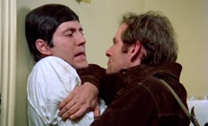
The Romero commentary has not been carried over, but Arrow has included another commentary from Travis Crawford, joined this time by Supporting Characters' Bill Ackerman, in which he notes that Romero had handed off the cinematographic duties to Hinzman – whose children appear in the prologue as a brother trying to scare his sister before a real threat appears – and endeavored to experiment with editing and sound effects. He also reveals that the original script by Paul McCollough – who would later shoot John Russo's MIDNIGHT and THE MAJORETTES and score Tom Savini's NIGHT OF THE LIVING DEAD remake – was more talky, and that Romero took the first twenty pages of it and expanded upon that into a more action-oriented story. The two commentators go on to discuss the ways in which the film anticipates both DAWN OF THE DEAD and DAY OF THE DEAD and ponder whether portions of McCollough's original talkier script may have inspired the scientists versus military squabbles of the latter film. In "Romero Was Here: Locating The Crazies" (12:24) Romero historian Lawrence DeVincentz takes us on a guided tour of Evans City, PA including many from NIGHT OF THE LIVING DEAD more so in the context of discussing the city's "Living Dead Weekend" than either of the films.
 In
"Crazy for Lynn Lowry" (15:54), Lowry discusses her early career from
I DRINK YOUR BLOOD, SUGAR COOKIES, and SCORE – in which she recalls that
other lead actress Claire Wilbur hated her – up through THE CRAZIES. She
recalls being cast by star/casting director Carroll, who she reveals was Hessell's
girlfriend (presumably the one who bought Romero's previous film for Cambist),
and that she was unaware of NIGHT OF THE LIVING DEAD at the time but got to
see both THERE'S ALWAYS VANILLA and JACK'S WIFE upon arriving in Pittsburgh.
She recalls Romero being generally accommodating of her acting choices but overruling
her on the death scene, which she now realizes was the right choice. A Q&A
with Lowry at the 2016 Abertoir Film Festival (35:51) includes more anecdotes
as the moderator focuses on what he defines as her "infection trilogy"
of I DRINK YOUR BLOOD, THE CRAZIES, and SHIVERS.
In
"Crazy for Lynn Lowry" (15:54), Lowry discusses her early career from
I DRINK YOUR BLOOD, SUGAR COOKIES, and SCORE – in which she recalls that
other lead actress Claire Wilbur hated her – up through THE CRAZIES. She
recalls being cast by star/casting director Carroll, who she reveals was Hessell's
girlfriend (presumably the one who bought Romero's previous film for Cambist),
and that she was unaware of NIGHT OF THE LIVING DEAD at the time but got to
see both THERE'S ALWAYS VANILLA and JACK'S WIFE upon arriving in Pittsburgh.
She recalls Romero being generally accommodating of her acting choices but overruling
her on the death scene, which she now realizes was the right choice. A Q&A
with Lowry at the 2016 Abertoir Film Festival (35:51) includes more anecdotes
as the moderator focuses on what he defines as her "infection trilogy"
of I DRINK YOUR BLOOD, THE CRAZIES, and SHIVERS.
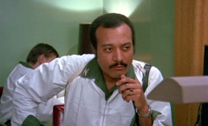
Also included is an audio interview with producer Hessel (4:32) recorded by his son in which he mainly gripes about losing money on the film when he changed the title on the ad campaign. Never-before-seen 8mm behind the scenes footage (6:25) comes with optional commentary by Lawrence DeVincentz in which he reveals that it was shot by actor Sam Nicotero – uncle of KNB effects artist Greg Nicotero (DAY OF THE DEAD) – who appeared as a deputy under the name "Tom Scott", which was provided for the Arrow release by the actor's son Frank Nicotero (STREET SMARTS). Rounding out the disc extras are the alternate CODE NAME: TRIXIE opening titles (0:35), filming locations (26:56) and collectible scans (6:04) image galleries, as well as two theatrical trailers (2:57 and 3:04), as well as two TV spots (1:03 and 0:33). Not included for review are the reversible sleeves featuring original and newly-commissioned artwork by Gilles Vranckx or the limited edition 60-page booklet featuring new writing on the films by Kat Ellinger, Kier-La Janisse and Heather Drain. (Eric Cotenas)